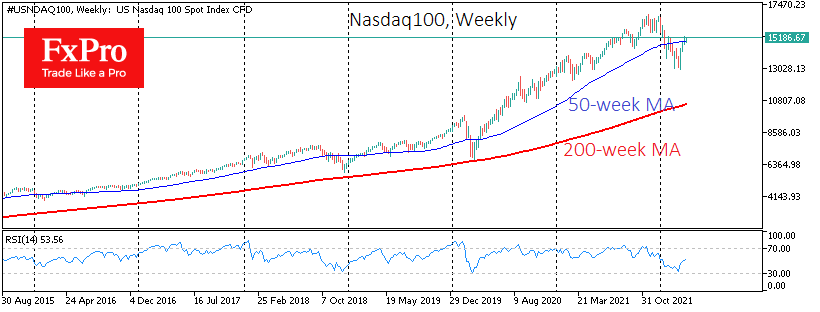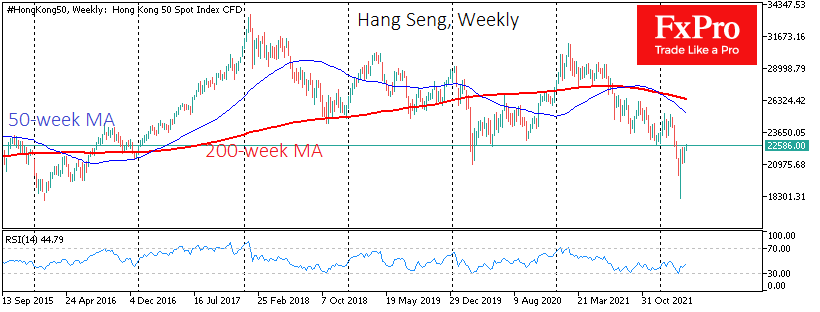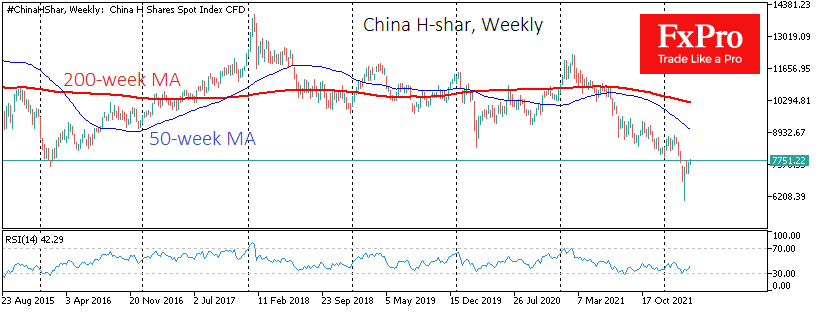Chinese stocks: from laggards to new market ideas
April 05, 2022 @ 11:38 +03:00
Nasdaq100 has added over 2% on Monday, in contrast with a more modest gain of 0.8% for the S&P500 and a barely notable 0.3% rise for the Dow Jones. But this is not a signal of general optimism from market participants; instead, it’s a switch in focus to Chinese companies.

Often the outperformance of technology-rich Nasdaq is taken as a signal of an accelerating economy and a move by investors to look for assets that outperform the broader market during an economic boom. But along with that, we would see the Russell Index, which includes 2,000 small US stock market companies, outperform. And it was only up 0.2% over Monday, struggling to move into positive territory by the end of the day yesterday.
On the other hand, Chinese companies are going from weak to growth drivers. However, this is nothing more than a recovery from lows after a year of aggressive declines.

Earlier in March, China’s H-shar lost more than half its value in 13 months of sell-off. Hong Kong’s Hang Seng was down 40% at its lowest point, plunging to 2016 lows.
In the first half of March, the most significant acceleration came on signals that China and the US had moved from trade wars to financial wars as the latter threatened to delist.
However, financial market turbulence is the last thing Xi Jinping needs this year, as there will be an election at the end of it, where he will be the leading candidate.
Improving the economic situation is often the most effective way for the incumbent to gain electoral support. And China has a lot to work with. Much the same can be said for the US, where the November Senate elections will be held. Democrat Biden’s record-low approval rating plays against his party in the coming elections and the rising stagflation threat.

The threat of delisting from the US is a blow to prestige, but it also closes off access to the softest financial terms for new companies and the deepest pool of liquidity. China could only afford it in the event of mania in Chinese markets and a booming Chinese economy.
But that is not the case right now. The PRC economy lags behind its forecast growth trajectory due to continued covid lockdowns. Achieving the expected 5.5% GDP growth this year requires stimulus and easing of monetary policy, regardless of inflation risks and without regard to the rest of the world, which is tightening policy. This is a favourable environment for the market, at least for the time being.
The Chinese equity market thus ceases to be a ‘sick man’, dragging global equity indices down and suppressing investor interest. On the contrary, even after returning to 5-week highs, Chinese equities still look very cheap, turning into a leading idea for the markets with a 9% jump in Baidu and a 6.6% rise in Alibaba on Monday.
Placed amongst others in the US, Alibaba and Baidu, the biggest of which are now pulling the indices up, spreading positivity across the entire tech sector. Twitter’s 27% jump in shares on reports of Musk’s 9.2% stake in the company says more about the market’s mood to look for growth drivers than how much this passive share of the Tesla CEO can help the social network. And that’s good news a couple of weeks before the start of the new reporting season after a worrying first quarter.
The FxPro Analyst Team







